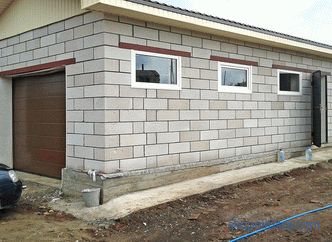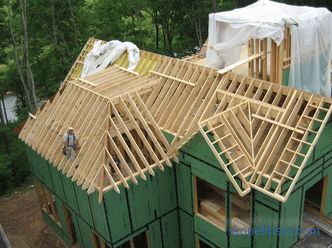In the modern world it is quite difficult to live in a house without gas. Electric heating is much more expensive, and solid fuel boilers are not suitable for everyone. The most convenient heating - gas, so most people use it. But there were places in the country where the centralized gas supply had not yet reached. These are remote villages, some holiday villages.
An alternative to centralized gas provision is a gas-holder. But not many people know what a gas-holder is - a system that provides a person with natural gas all year round in places where it is unrealistic or very expensive to carry a centralized gas. Thanks to a gas-holder for a private house, many people felt the benefits of civilization and additional comfort in life.
The price of gas holders for a country house can be quite noticeable, but such tanks have paid off over the years, because the cost of natural gas is constantly increasing and can change a lot over the course of a year. Systems are becoming more popular. Therefore, questions about the gas tank - what it is, how much it costs and how to install it - are widespread. In the article we will answer them.
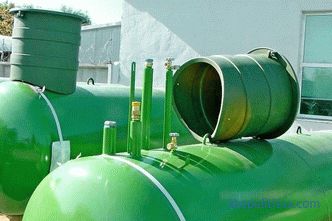
Gas-holders
What is a gas-holder: general information
Gas-holder - capacity intended for long-term storage of natural gas or other gaseous substances (biogas, liquefied petroleum gas, air, etc.), but for heating purposes, tanks are filled with liquefied propane-butane. Gas-holders are used both on an industrial scale and for private use.
This autonomous system is a large reservoir for storing gas reserves, which makes it possible not to depend on the state and independently regulate the value of utility bills for gas supply. Having filled the tank once or twice a year, depending on the volume of the tank, you can safely use the gas oven to cook and heat the house.
By volume, gas-holders are different - from 2500 to 20,000 liters, small tanks are used for mobile gas-holders. Since these devices require increased attention, it is imperative to install automatic protection systems that monitor the gas pressure inside the tank, control the distribution and quantity of fuel, and are also responsible for the safety of the autonomous system. A gas-holder, the photo of which is shown below, can provide with gas a large private house.
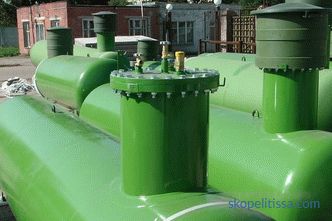
Horizontal gas-holders of large volumes
Types of gas-holders
Gas-holders for private use have been used for more than a dozen years. Previously, they were very large, cylindrical buildings with adjustable height and were used to provide gas to entire areas in cities. Such systems are called variable volume gas holders and in some cities such buildings have survived to this day, albeit already as museum exhibits.
What is a gasholder for a private house today? Modern versions of tanks are used mainly for the gasification of private houses, villas, country cottages and have a more compact form. They have a constant volume, they are made of a very strong metal and can be both vertical and horizontal. In addition, gas tanks are divided into ground and underground.
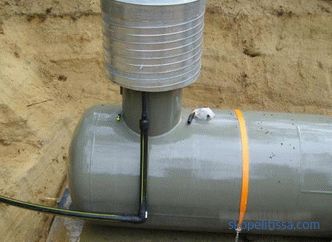
Installing an underground gas-holder
Ground-based. Installed on the surface of the land. Gas tank for a private house of land type is beneficial in that the tank is easier to maintain and it is much easier to detect corrosion or other changes and breakdowns. But we should not forget that with such an installation in winter, the ability to evaporate at the air-gas mixture drops sharply, in addition, the ground version of the tank requires additional security measures.
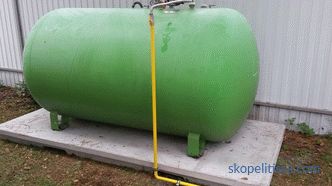
Ground small gas tank
First of all, care must be taken to ensure that direct sunlight does not fall on the tank. Despite the fact that the tank body is designed to withstand high temperatures, for additional security, it is better to install a gas tank in the shade.
In order to significantly save space on the site, when choosing a ground-based gas tank, they prefer to prefer vertical tanks with a small volume, which are connected into a single network. In terms of operation, the vertical gasholder is not inferior. The photo below represents horizontal and vertical tanks of different volumes.
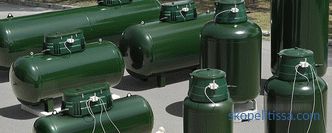
Vertical and horizontal gas holders
Underground. At first glance, the underground installation of a gas-holder is associated with additional expenses, which consist in the need to attract special equipment. But the underground location of the system provides protection from the cold, additional security and constant flat gas pressure.
To eliminate tank freezing and avoid mechanical damage, underground gas tanks are buried to a depth of at least 60 cm. With regard to the tank volume, you can easily place a tank from 2500 to 10000 liters in a section of a country or private house. this gas tank will not spoil its appearance landscaping.
The tank is buried in the ground so that only the throat, to which the filling unit is connected, remains on the surface. Gas enters the house through pipes running from the node to the building.
Vertical underground gas-holder at the installation stage
On our site you can find contacts of construction companies that offer home insulation services. Directly to communicate with representatives, you can visit the exhibition of houses "Low-rise Country".
Vertical. They are very similar to huge cans, and differ from horizontal ones in that they occupy relatively little space on the lot. But with large gas consumption, such tanks are additionally equipped with evaporators, which help provide the consumer with the desired gas pressure. This makes the installation noticeably more expensive and increases operating costs.
Thus, a vertical tank is only beneficial if gas is used for cooking and providing hot water at home in the summer when it needs relatively little. It is also necessary to take into account that vertical gas holders are most often designed for underground installation, which means that high installation costs are added to low efficiency.
Installing a vertical gasholder
Horizontal. They are considered the most common in our regions due to the fact that they have a large area for evaporation of the so-called “liquid phase”. In the horizontal version of the gas tank, there is always a sufficient amount of air-gas mixture, which is enough to ensure normal pressure with increased consumption. Therefore, in order to ensure proper evaporation, natural conditions are sufficient and additional devices are not required, and this is a great savings in money. Horizontal gas-holders are capable to provide sufficient pressure even in hard frosts. There is only one deficiency - it will take a lot of space to install such a tank.
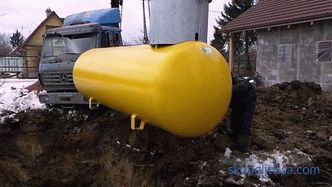
Installing a horizontal gasholder
Mobile gasholders
If housing is not used constantly or there is not enough free space for that To position the stationary device, it is reasonable to use a mobile gas tank. What it is and how they are used: it is also a gas supply device, only in small sizes, they are used as needed, for example, in the summer period, and when it is not needed, it is simply put in storage.
Advantages:
-
Such devices can provide room for gas during the summer season, and for the winter you can take them with you;
-
It is possible to provide several objects with gas alternately;
-
No special equipment and free territory in the area for installation and installation is required;
-
Since the volume of the mobile the gas storage is small (about 500-600 l.), respectively, is small and its cost.
All gas-holders require registration with the relevant authorities and the mobile version is no exception.

Mobile gas tank
Operating principle
The working principle of the gas tank is quite simple: the gas is pumped into the reservoir, and thanks to the fact that the tank is not completely filled, an air-gas mixture (propane-butane) is formed in the empty space of the storage. In order for the process of natural evaporation to take place efficiently, several rules should be followed:
-
You should not fill the container with liquefied gas by more than 85%.
-
When installing the tank, it is strictly necessary to take into account that it should not be cooled below 0 °, therefore, if a ground gas tank is installed, it will be necessary to warm it.
-
If it is assumed that the evaporation area will be small (for example, in vertical tanks), then you need to consider an additional evaporator system.
The gas mixture flows through the pipeline into the house, as well as through a regular highway. Filling the gas tank is carried out by specialists working on a car with a filling tank. The procedure itself is reminiscent of refueling a car at a gas station.
It may be interesting! In the article on the following link, read about how to insulate a house from a bar from the inside.
For more information about the gas tank and its installation, see the video:
To control and adjust the process, the system provides special automation if you need to shut off the flow, you just have to turn the special crane. Removal of excess pressure is carried out using a special valve.Accounting for the remainder of the gas is due to the warning system, which will alert the owner to fill the tank.

Gas tank automatics
How to install the turnkey gas tank
You only need to order a gas tank for a turnkey private house in a specialized company that has the necessary license. Installing a gas tank with your own hands is impossible - it is illegal.
Gas supply for the tank, refueling, connecting the gas tank to the gas boiler and all service work must be carried out only by certified workers from special companies. It is an explosive equipment and requires proper maintenance by technical experts.
Different volumes of vertical and horizontal gas-holders
Preparatory stage
To properly install the gas-holder, you must first carry out the preparatory work. All dimensions of the pit and its location relative to the building must comply with the standards and installation requirements for gas-holders.
-
The pit should be 0.5 m larger than the tank on all sides.
-
A concrete slab with mounts for the paws of the tank is laid at the bottom of the pit.
-
A trench under a trunk should not interfere with or intertwine with other communications.
-
The depth of the pipeline trench must be at least 1.70 m, and the slope towards the house is at least 5 °.
-
The distance to the residential facility from the gas-holder is at least 10 m.
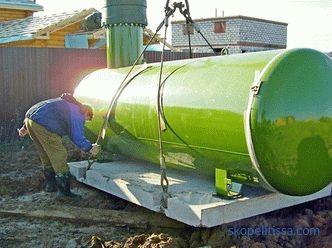
Delivery of the gas-holder to site for installation
It can be interesting! In the article on the following link read about insulation for exterior walls of the house.
Procedure
The field of completion of the preparatory work is brought to the object by storage, carefully removed from transport, and installed on a concrete pad. It is very important not to damage the coating of the tank, in order to avoid rust. Having carefully installed the storage in the prepared place, it is necessary to fix it securely by bolting the paws. This will avoid possible movement of the reservoir during shrinkage of the soil. Installation is required strictly in a horizontal position.
The precise fulfillment of this requirement during the installation of a gas-holder makes it possible to avoid the occurrence of an error in the indication of the level of the liquid phase of the gas inside the tank. In addition, the installation of a gas tank requires the implementation of measures for lightning the tank and its protection against electrochemical corrosion.
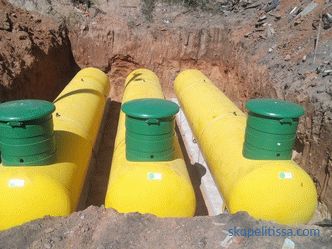
Installation of three small underground gas holders at once
After installing the gas holder, work is carried out on the construction of the gas pipeline. The gas supply line consists of steel pipes with a corrosion-resistant coating or plastic, the material for the manufacture of which is low-pressure polyethylene. The pipes are interconnected by welding and laid on a sand cushion of the trench.
The foundation pit and trenches are first covered with sand, which is well compacted. Along the entire length of the gas pipeline trench, a warning tape is laid, which will prevent damage to pipes during further ground works. Then soft ground is used, in which there are no stones and other solid particles. The top layer can be filled with fertile soil, which subsequently grow flowers.
For more information about autonomous gasification, see the video:
If you want to buy a mobile gas tank, its price will be much cheaper usual, besides installation on a site is not required.
How to calculate the volume of a tank for a private house
More does not mean better, therefore, you need to calculate the volume of the gas tank correctly. This is done based on the technical characteristics of the heating boiler, the area of the house, and the number of cooking surfaces.
Horizontal gas-holders are selected with a margin of 15% of the calculated consumption figures, and vertical ones with a margin of 10%.
The correct calculation of the volume of the tank allows you to choose the right gasholder for a private house, because the prices for them mainly depend on the volume, which means that you will not overpay for the extra and unnecessary volume of the tank.
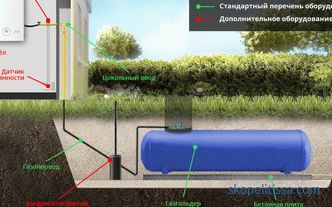
Installation of a gas-holder for heating a private house
Cost of a gas-holder and its installation
Choosing gas-holders for a private house , prices in the Moscow region can be revised for a long time, since they depend both on the manufacturer and on the volume of the tank itself. At first glance, everything is simple: the larger the reservoir, the higher the price, but the economic benefits of small vaults are sometimes deceptive. After all, a small tank is required to fill up more often, and this is an additional cost for the delivery of gas. Therefore, it is necessary to choose a gas-holder, having previously calculated the tank volume required for heating a house.
If you have already chosen and purchased a gas tank, the installation cost will be calculated specifically for you by a specialist who arrived at the work site. Usually, prices vary depending on the distance from the site where the installation will be carried out, the size of the tank and its type, as well as the length of the pipeline. The installation cost can vary from 40,000 to 100 thousand rubles. This includes everything (land and installation work, a reinforced concrete slab, a set of materials, delivery), except for the cost of the gas-holder itself.
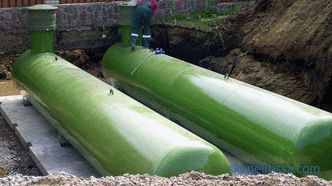
Installing two gas-holders for heating a private house
It might be interesting! In the article follow this link read about how better to warm the house outside.
Conclusion
Regardless of the type, the gas-holder can fully satisfy the gas needs of a private house. And if there is no possibility to connect to the centralized heating, the gas tank will be a good solution. In addition, despite all the costs of installing and purchasing the tank itself, it is more profitable than using electric heating.
